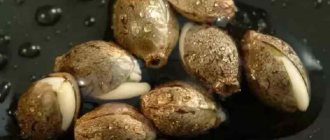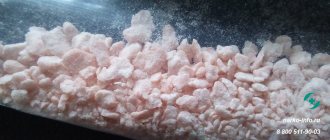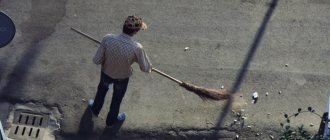| « | “One of our Russian agents, a former ferocious bandit, told me that in the camps they made themselves some kind of cunning drink from tea - “chifir.” It is both intoxicating and invigorating. Shouldn't we try it? “Müller suddenly laughed: “You’ll still have to drink this drink in their camps, so isn’t it time to master the technology in advance?” | » |
| - Seventeen Moments of Spring. Yu. Semenov | ||
Chifir
(also
chifir
,
chefir
,
chief
...) - a Siberian racial drink for a cheerful mood.
It turns out to be a strong brew of simple tea. Kosher zamutka
stimulates discourse, the desire to create and create, reminiscent of the effect of small doses of ephedrine; and unlike vodka, it does not change the entire paradigm: chifir is quite suitable in difficult situations and is integral to the culture of closed establishments. In general, chifirists are such fuckers without a disco, but with a chainsaw and wearing felt boots.
Chemical composition of chifir
The composition of chifir is completely different from classic strong tea. Due to the fact that during its preparation it is subjected to repeated heating, the theine contained in tea leaves is destroyed, and new organic compounds appear. Alkaloids enter the infusion, as well as guanine and adenine, which do not dissolve during classical brewing. Is chifir harmful? Very much, because guanine and destroyed theine are dangerous to health.
You may be interested in: Tea acidity - pH indicator as an indicator of your health
Effect on the body
It is customary to drink chifir to increase tone and restore vigor. Research has also confirmed the mild narcotic effect of the tea drink. It slightly changes perception and consciousness, improves mood, and gives a feeling of relaxation. The person becomes more talkative and active. There is a heightened awareness of your capabilities, you want to immediately engage in at least some activity.
Intoxication usually begins to appear 15-20 minutes after drinking chifir, and its duration depends on the strength of the drink and the individual characteristics of the body and can last several hours. Narcologists often draw an analogy between the effects of psychostimulant tablets and a tea drink. Coming out of this state is accompanied by a hangover and is subjectively perceived as extremely unpleasant: drowsiness appears, the head becomes heavier, all senses become dull, and dyspeptic disorders are possible. The transition to sobering up is noticeably more difficult if chifir was drunk on an empty stomach.
This effect of seemingly ordinary tea is explained by two factors. Firstly, when preparing chifir, those substances that normally remain in tea leaves are boiled into it. Secondly, the concentration of all chemical elements in the tea drink is off scale. This leads to temporary activation of brain activity, relief of tension without a hypnotic effect, stimulation of intestinal motility or, conversely, relaxation of smooth muscles.
Beneficial features
Chifir is a strong stimulant that can be consumed occasionally and in small quantities. If you add sugar to the drink, this specific effect will increase many times over. Nutritionists and narcologists recommend using chifir in diluted form to reduce its negative effects.
Advice No less effective, but much safer for the body, is simply strong tea with sugar. And if you add a slice of lemon to it, it will help normalize low blood pressure.
True, this approach also has several negative aspects. During boiling or prolonged infusion of tea leaves, few useful substances in its composition are destroyed. At the same time, harmful alkaloids are formed in the liquid. They can accumulate in tissues, provoking pathological processes.
[edit] Quotes
In one of his epic stories, the writer (not a writer, a shkolota!) Varlam Shalamov mentioned that in the novel “The Children of Captain Grant” by the writer Jules Verne, a chifir is mentioned:
| At eleven o'clock tea was served. It was prepared in the best possible way, in English. But Paganel wanted to try Australian tea, and they brought him a liquid that looked like ink. No surprise - half a pound of tea was boiled in a liter of water for four hours! Although Paganel winced, he declared the drink excellent. |
| "Captain Grant's Children", part two, at the end of chapter 17 |
It takes place in Australia. Australia in the British Empire was a direct analogue of sunny Magadan, which cannot but symbolize.
And all of us, Pelevin, of course, could not do without mentioning a substance, especially one that is so primordially ours and historically Soviet.
| Yes,” said Volodin, “but when you came to Paris for a loan, do you know what you did?” I went to a restaurant with their banker to have a heart-to-heart talk at the table. And he got drunk, like in the Slavic Bazaar, and started yelling: “Waiter, two buggers and a bucket of chifir!” He wasn’t gay himself, he was just in the zone... […] The banker liked it all very much. They were always fine with pederasts there, but they never tried chifir. It even became fashionable there, it’s called tea a la Ruesse Nouveau. |
| “Chapaev and Emptiness” © Pelevin |
The very subtle troll Sergei Dovlatov could not help but remember the chifir:
| Near the instrumental I slowed down my steps slightly. The chifirists gathered here at night. A tin soldier's mug was filled with water. They poured a packet of tea in there. Then a razor blade on a long steel wire was lowered into the mug. The end of it was thrown onto the wires of a high-voltage line. The liquid in the mug boiled within two seconds. The brown drink acted like alcohol. People started gesticulating excitedly, shouting and laughing for no reason. The chifirists did not instill any serious fears. Serious fears were instilled by those who could kill even without chifir... Shadows moved in the darkness. I came closer. The prisoners sat on potato boxes around the chifirbak. When they saw me, they became quiet. “Have a seat, boss,” came a voice from the darkness, “the samovar is ready.” “Sitting,” I say, “is your concern.” “Competent,” answered the same voice. |
| "Zone" |
And a couple of harsh Siberian men - Lazarchuk and Uspensky:
| I found tea, but I had to go to the nearest pharmacy for alcohol. The compatriot, who introduced himself as Viktor Platonovich, a writer from Kyiv, demanded not a traditional pot-bellied teapot as a vessel for brewing, but an empty tin can, preferably slightly rusty. I nodded to confirm the validity of the order. Viktor Platonovich said that ideally the water should be boiled over a fire, but this was already a fierce aestheticism. It is enough that the jar, as expected when brewing chifir, was covered on top with a painter’s mitt lying around in the cafe after repairs - in the absence of a tarpaulin top. Viktor Platonovich said that Earl Gray, of course, is not the same, although it will do for the French. When the waiter brought a can of steaming tar-black drink from the stove, the writer from Kyiv took a bottle of alcohol and began to flavor the brew in a thin stream. “This ruff, gentlemen, is called the Kolyma Awl,” he said. – After it you can not sleep for three days. Helped a lot in Stalingrad... |
| "Look into the eyes of the monsters" |
And the Orthodox fantasy writer Rudazov is chirped by devkatsi
- a stable hybrid of Nokhchi with donkey devas.
Where did the name “chifir” come from?
This drink appeared many years ago, so now it is difficult to say with certainty where the name came from. According to some versions, the term comes from the word “chikhir”, which was used to call wine in Caucasian countries.
A similar word “chagir” was used to describe a tea drink in eastern Siberia. In addition, the peoples of Siberia also have the word “chikhir”, which means a dark-colored intoxicating substance. All versions fit the description of the chifir, and each of them has the right to exist.
These days, chifir is associated as a prison drink. I don’t know how things are now, but several years ago it was actively used by watchmen and stokers in order to remain invigorated for as long as possible. Even my truck driver buddy couldn’t do without this elixir, so as not to fall asleep at the steering wheel during the flight.
Literature
Chifir is also mentioned by Sergei Dovlatov in his story “The Zone. Notes of a Warden" and Anatoly Marchenko in the novel "My Testimony". The recipe for making chifir and the situations for its use are described in the first part of Mikhail Demin’s autobiographical trilogy “Blatnoy”. Chifir is regularly mentioned in the works of Oleg Kuvaev, especially the novel “Territory”.
The text of the novel specifically states that during the Great Patriotic War, when the Country demanded gold and other minerals, geologists prepared the so-called “doping” - chifir mixed with alcohol, which served as a universal stimulant and cure for all diseases. True, O. Kuvaev also notes that the majority of those who regularly consumed this mixture experienced early mortality at 35-37 years.
- Pokhlebkin V.V. Tea: Its types, properties, use. — 3rd ed., revised. and additional - M.: Light and food industry, 1981. - P. 64. - 120 p.
This page was last edited on February 7, 2020 at 11:26 am.
How to brew chifir
The usual amount for one is a matchbox (10-12 grams). Although they don’t drink chifir alone - translation of the product. The drink has deeper purposes: discussions, communication. Take simple black small-leaf tea. Large leaf is needed more, but it must first be broken, reducing the leaf fraction. Usually they use the simplest and most inexpensive tea - since the drink itself originated in a place where it is always difficult to get good tea. Now, of course, you can find different types of tea in prisons, but tradition is tradition. Simple Krasnodar or Georgian small-leaf black tea is the best option. Sometimes they used green, also small-leaved and cheap, you need more of it. Flavored teas are not suitable. The strength of chifir is its main indicator. “Poison” is the highest characteristic of a brewed drink. Recipe: add tea to boiling water at the rate of 1 part tea to about 2 parts water. It all depends on the container in which chifir is prepared. The classic recipe involves filling the container 100% so that dry tea poured into water reaches the edges. You can't mix it. Simply remove from heat and cover immediately. Infusion time is 10-15 minutes. An external sign of a finished brew is the leaves that have fallen to the bottom. After this you can drink chifir. If it is possible to filter, you should filter. But a strainer is a rare thing in prison. Unfiltered chifir can be settled in a “chifir tank”. Pour it from there into the mug and back several times to separate the tea leaves and mix the chifir. This is called “hanging out with the chifir”.
Cooking methods
Before making chifir, it is important to understand that initially it was exclusively a prison drink, helping prisoners survive. Today there is no need to use it, but preparing chifir will satisfy the curiosity of those who want to taste it personally.
How to brew chifir step by step:
- Prepare an enamel container with a volume of 0.5 liters.
- Fill it 2/3 with water and bring to a boil.
- Add 5-6 tablespoons of tea leaves to boiling water.
- Bring to a boil, stirring the liquid occasionally.
- Cover with a lid and simmer for 2-3 minutes or remove from heat and keep the infusion covered for 7-10 minutes.
- Cool the resulting liquid slightly and strain.
Before cooking chifir, it is important to decide on the starting raw materials. It is allowed to use loose leaves or granulated black varieties. Chifir is not made from green tea, as the drink turns out unbearably bitter.
You can prepare a homemade strong drink from bags. The chifir recipe is simple. Take 7 sachets for one 250 ml cup. They are dipped in boiling water, covered with a lid and left for 5-7 minutes. It is important to choose varieties without flavorings. Flavoring additives will negatively affect the quality of the drink.
It is important for beginners to know how to drink chifir. It is consumed slightly chilled. If the first sip causes nausea, you can put a few grains of salt under your tongue. Sugar is not added to chifir, as it enhances the negative effects of alkaloids.
The dangers of eating chifir
Those trying the drink for the first time need to be especially careful. If you experience discomfort at the first sip—severe nausea—you should completely stop using chifir in the future.
By the way, to relieve an attack of vomiting, you need to eat a small pinch of salt.
I remember one incident when the owner of the mowing farm where we were messing around took his first sip of chifir from a thermos prepared by the craftsmen for an invigorating drink.
What happened to him is a must see! They rinsed him mercilessly, the birds stopped singing at his loud roar, and we were dying of laughter until our stomachs hurt. A few days later he admitted that all night after mowing he looked at the ceiling with dazed eyes, trying to fall asleep.
It has long been proven that chifir has an effect on a person’s mental state. Decreased concentration, heaviness in the head and rapid pulse are only the safest of symptoms.
When boiling, tea leaves release substances that are dangerous to humans - guanine, adenine and theine, so you should not brew the tea leaves several times, so as not to expose the body to serious risk. The high concentration of caffeine also makes the drink hazardous to health.
To prevent your pulse and blood pressure from rising sharply, you should never add sugar or any other sweeteners to chifir. Chifir tastes very bitter, which not everyone likes.
Therefore, if you really want to sweeten it with something, it is better to take sweet candies or caramels and eat it with chifir, but do not add anything to the drink itself.
You need to drink chifir a little at a time, in small sips, while it is hot. It is not recommended to eat anything within an hour after consuming chifir. If you use chifir for a long time, you become dependent on caffeine, and the person feels depressed.
[edit] Gulag classics
“Another method, very similar to the previous one, which is now an old classic, sometimes used in extreme chamber conditions. For a long time, there were no electrical outlets in prison cells. And if there are any now, then they have the ability to be disconnected from the corridor by evil garbage. As a rule, the switch for sockets is the same as for the light. And it is nearby.
Sometimes nasty garbage deprives the camera of electricity, for example, due to lights out from 22.00 to 6.00, despite the fact that there are three people per sleeping place, like on old submarines, and those on the waking shift want to chifir. Then a torch is made. A long piece of lard is cut out - the candle wick. It is wrapped in a strip from a sheet, which, due to its old age, is comparable to blotting paper. The candle is ready. The flame is small and smoky - that’s why the classic chifir mug is smoky. Using a candle, slowly bring the water with the pre-filled tea to a boil. They don’t pay attention to the soot and smell of burnt lard in the cells where they smoke and are full of sweaty bodies.
In the absence of matches in the chamber, fire is produced by rubbing cotton wool from the mattress. A tube is made from cotton wool, which is rolled along the floor under pressure with a heavy boot. I saw it in person and it works.
[edit] And one more way
If it is impossible or unwilling to brew chifir, those who are addicted to this drink eat tea (less often coffee) dry. The tea is poured onto the palm, with a sharp movement, in the manner of nasvay, thrown into the oral cavity and, after chewing, swallowed. Then he drinks it down with cold water, and in particularly advanced cases, he doesn’t drink it down at all. Despite all the fun of this method, the desired effect is still achieved - caffeine will get into your blood even without heat treatment of the carrier, Anonymous.
[edit] About chifir varieties
Granulated tea gives a very strong, poisonous taste. Large leaf - rich and soft. Green tea is very mild, even too mild. Aesthetes blend these basic types of tea.
What do they drink from? The classic utensil for preparing chifir in chamber conditions has been the zechka for decades. Zechka is a 0.5 liter aluminum mug, which is issued in prison and is also used in the army. Only a sophisticated sadist could come up with a mug made of “winged” metal - aluminum is a remarkably heat-conducting metal. While there is boiling water in the mug, the temperature of the aluminum handle is exactly the same. When you drink from it, the metal burns your lips more than the contents. The feeling is that you drink cooled chifir, but the zechka is still hot. To hold the prisoner with the chifir in his hand, the prisoners braid her hand with ropes from the remains of “horses” - long ropes woven from loose clothing for inter-cell communication. At the first opportunity, the cap is changed to a steel enamel mug. The only advantage of the prisoner is that you can scratch something romantic on it, like “Kolyma 1937.”
[edit] Espresso
A “moka” coffee maker is a know-how for speedy personal cleansing: charge the pot with cold water over high heat. The speed and thoroughness of filtering here is extreme, and the high temperature and pressure make it possible to extract goodies that are not much worse than with a long boil. Chifir comes out very poisonous and hot, and the dose is small, so you can dilute it.
[edit] Not quite true
(reminiscent of a Mongolian tea recipe)
Take a glass, pour milk into it, pour it into a saucepan of the ladle system. Add a glass of water there, throw in a cube of refined sugar, put it on the fire, bring to a boil. In boiling milk, add 8-10 heaped teaspoons of tea, preferably large-leaf granulated tea. Turn the heat down to low, add a small piece of butter, and simmer for 10-15 minutes. After this, drain the liquid; if everything is done correctly, you will get exactly a glass of light brown broth. We drink it hot.
Unlike other varieties, this chifir is easy to drink, without causing gagging and does not give a pronounced “high.” Allows you to keep a fresh mind and efficiency all day long after a sleepless night. When drinking 3-4 glasses in the evening, you will have to strain the interaural nerve node, figuring out what to do cheerfully all night.
Hard-core truck drivers drink something like this to avoid falling asleep while driving - a tradition observed in India, which is why it is also called “Indian”. Depending on the amount of brewing, seagulls are distinguished “for 200 km”, “for 500”, and OMG, “for 1000”. They don’t have extra money for fancy options with ginger, cardamom and other cinnamon. The recipe was read in the vastness of FIDO at the end of the last millennium, and was repeatedly tested personally with consistently excellent results. In turn, the recipe is similar to the so-called Kalmyk tea
.
By the way, a very similar brew (only with condensed milk instead of regular milk and, accordingly, without sugar) is consumed by the most dedicated connoisseurs at the “big” festivals “What? Where? When?”, lasting more than one day, especially at tourist centers. For example, playing the so-called “night brain” (from two in the morning until seven in the morning) without such an “energy drink” is below average pleasure. In general, try it.
In fact, this method of brewing tea came to India from Tibet, where “chasuima” (usually mixed with fried barley flour tsamba) constitutes slightly more than the entire diet of local collective farmers, and in general, boiled milk-butter teas are typical for the Mongols and peoples close to them in their way of life, in particular the Tibetans. However, racial lamas are so strict that they often drink their decoction without milk at all; they take yak butter, and even the most rancid one they can find (in fact, due to the characteristics of the area, climate, and the total poverty of the local population, it is impossible to find non-rancid butter in Tibet it’s only possible in a couple of cities), and instead of sugar they put salt and a little soda there.
Dry chifir
, aka “shara”, aka “shaga”, aka “puer resin”, aka tea infusion, in Chinese “cha-gao”.
Under different conditions, this harsh product is prepared in different ways, but it is always the same thing: tea extract condensed until dry. Many, many tea leaves or prepared tea are poured with water in a cauldron, brought to a boil, but not boiled, squeezed out on a press, then the process is repeated again, and again, and finally the resinous black-brown liquid resulting from such atrocities is dried. almost dry, rolling it into pea-sized pills. One pea is approximately equal to a glass of very
strong tea. You can brew it with boiling water, as they do with “pu-erh resin,” or you can simply dissolve the bitter pill in your mouth—the result will always be the same: the usual burst of vigor from caffeine. Naturally, the brew from the leaves of pu-erh trees will not have a hellishly bitter taste, and therefore it is this product that is noble, and all others are designed for hardened and undemanding people, that is, hunters and other travelers to deserted places, where the weight and volume of supplies are very critical , and, of course, prisoners. In the latter case, the “ball” is not brought to a semi-dry state, but the bottom of a T-shirt or T-shirt is soaked in it - thus providing a supply of caffeine for those unfortunate people who end up in a punishment cell or BUR. Used in the latter case, it is extremely simple - you chew a rag until you feel the chifir vigor. In the punishment cell there is no time for rituals with a mug and no time for fat - I wish I could live! It should be noted that such exoticism is found where the Chinese and Mongolian borders are close, that is, in the Far East and Transbaikalia, but in Western Siberia and the European part of this country it is almost unknown.
Chifir from puerh
.
It has nothing to do with prison realities, because it is exotic and expensive. It became widespread in the wake of the popularity of exotic teas among domestic redneck rappers. Usually, black shu-pu-erh is used for brewing, a lot of
black shu-pu-erh.
The finished product smells like autumn leaves and cinnamon, is radically black in color and is almost opaque. The taste, unlike the classic chifir, is not at all evil, but is actually very pleasant - absolutely non-astringent, sweetish-earthy, with a moderate caffeine bitterness. As a result, it is very insidious: getting a severe caffeine overdose with tachycardia, violent vomiting, diarrhea and terrible weakness is easier than easy, especially if you are a young schoolboy who listened to some Basta.
In moderation, it is quite safe and suitable for an emergency boost in the morning. A sort of analogue of a cup of very strong coffee, only less bitter. In Mongolia and Tibet, this method of brewing with bringing to a boil is quite common, but sophisticated Chinese consider it barbaric.
Caucasian version
Vitaly Lozovsky in his book “Everything about Life in Prison” gives another version of the appearance of the chifir recipe. According to his data, the prison intoxicating drink owes its origin to the peoples of the Caucasus. From time immemorial, they have been brewing homemade wine from dark grape varieties - chikhir. This word was used to describe both the finished product and the grape must that had not yet fermented.
Chikhir, at its core, is a semi-finished product. It does not yet have the required strength, but there is a strong aroma of grapes. This young wine is very popular in the mountain villages of the Caucasus. It was well known in the central regions of Russia. Mentions of chikhir can be found in the dictionaries of Dahl, Ushakov, etc.
Chifir in prisons [ ]
Some prisoners cannot break the habit during their long stay in prisons and continue to drink after their release. When abruptly stopping use, such a person has a strong desire to drink the infusion again.
It is believed that without tea in prison, full communication is impossible. All important issues are resolved with a mug passed around the circle to all participants in the conversation.
In prisons, they usually drink chifir twice a day, sometimes three times, but this is considered an exorbitant luxury, and besides, if you consume chifir too often, you can easily get an overdose, and as a result, headache, intestinal cramps, vomiting, overexcitement or apathy.
Benefit or harm?
Those who have visited places not so remote talk about the health benefits of chifir. Moreover, they claim that in conditions of unfavorable climate and poor diet, chifir was almost the only source of vitamins. It is difficult to substantiate these statements, but the harm of the “prison drink” is obvious.
Chifir has a negative effect on:
- Nervous system. Provokes disorders of consciousness, neuroses and depression.
- Cardiovascular system. Chifir is highly not recommended for people with heart problems. It can cause spasm of cerebral vessels, and with a certain predisposition, provoke a heart attack or stroke.
- Gastrointestinal tract. Can cause stomach pain, nausea, and vomiting.
- Oral cavity and teeth. Long-term consumers of chifir rarely can boast of not only the health of their teeth, but their presence in general.
It is an established fact that Chifir addiction exists.
Chifir was invented in prisons. It is one of the few legal drugs available to prisoners. Despite the extremely severe impact on the body, chifir remains popular in prisons. However, its consumption “in the wild” looks at least strange, if not suicidal, habit.










